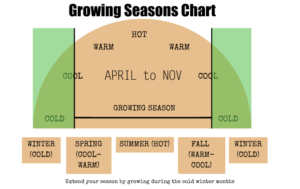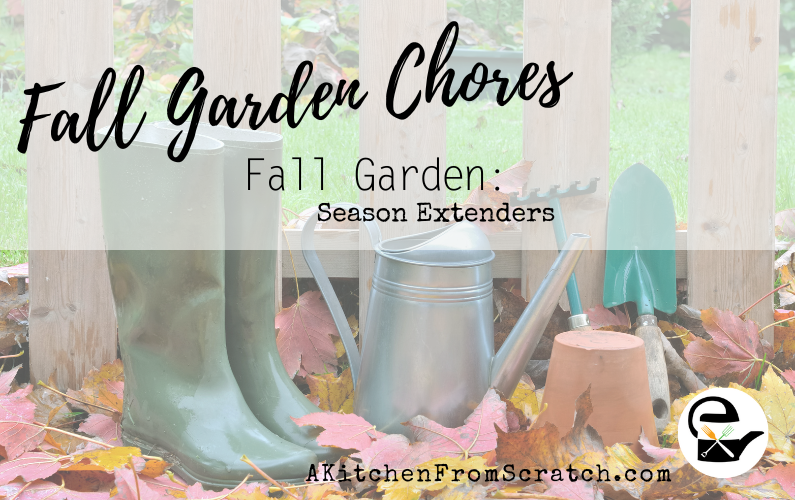Extend Your Growing Seasons
Your fall and winter garden can be a treasure trove of fresh produce long after many gardens have begun to wilt. Learn how to extend your growing season and the tools that can revolutionize what you plant, how you grow it, and even when it’s ready to enjoy!
How you treat your garden during the fall has a significant impact on a couple of things:
- How long can the Fall season be extended
- How healthy the soil is in the springtime
- How big the yield is
So, what chores should you be adding to your list to ensure you can enjoy delicious homegrown produce throughout the winter?
Extending your growing season takes a little planning, but the prep will be worth it.
Here are a couple of things you need to know:
Dates for your Garden Journal:
- Last spring frost for Salt Lake, UT, April 7
- First frost for Salt Lake, UT, Nov 1
- The growing season for Salt Lake, UT, is on average 207 days

Data: U.S. Climate Normals | National Centers for Environmental Information (NCEI)
Temperatures to watch out for:
- A light freeze is considered 29 – 32 °F (tender plants will be killed)
- Moderate freeze is 25 to 28 °F (most vegetation will be destroyed)
- Sever freeze is 24°F (most gardens will take heavy damage)
Using season-extending structures can prevent much of the impact of light and even moderate frost.
How to extend your growing season with structures
Here are some tools and techniques that you can use to extend your growing system further into the fall.
Row covers
You need to maximize the light that the plants get without allowing plants to be damaged by the cold. Row covers are permeable, meaning air, light, and water can get in. You can use two types of row covers to protect your plants.
- Heavy row covers allow heat to become trapped and should be removed when outside temps are above 60 degrees, or the inside temps are 86degrees Fahrenheit.
- Lightweight, breathable row covers don’t trap heat. And are used to protect new growth from birds and insects from eating new seedlings.
- Covers should be removed when the starts are mature and start to show flowers so that they can be pollinated.
Note: row covers will only keep the row warmer than the surrounding air by up to 3 to 5 degrees, so they work best in an early or late frost.
Cold frame
Cold frames are one of the most common ways to extend the growing season. Cold frames use the heat from the sun to stay warm – similar to a greenhouse. The slanted transparent roof and no bottom make the cold frame easy to place and remove.
The benefit of cold frames is that they can be made from various materials.
- Cold frames offer various degrees of temperature and wind protection.
- You can choose from decay-resistant wood or concrete blocks, bricks, and hay bails.
- Your cold frame should be tall enough to accommodate the tallest plant.
To further extend your growing season with a cold frame, you can cover it with blankets, mats, or tarps to help your crops get through most of the winter.
TIP: Use water to maintain a more consistent temp inside cold frames. Line the black water bottles up along the north wall of the greenhouse with their black sides facing inside. Stack the bottles instead of arranging them in rows to ensure that each bottle receives the maximum sunlight.
Cloches
You can use small plastic cups or glasses placed over individual seedlings and smaller plants. They act like a mini-greenhouse. Your clothes need to be placed deep enough into the plant’s soil so it doesn’t move in windy conditions.
- Remove it if the temperature reaches 50-60 degrees Fahrenheit outside the cloche.
- Cloches protect from heavy rain, wind, and some levels of frost.
Plastic tunnels and covers
You can make a plastic tunnel from translucent plastic sheets, pulled-over hoops made from wire, rebar, and flexible PVC pipes. Ideally, your wire will be 10-gauge or above.
Aim to arch the cheers 18 inches above the bed and tuck the edges (and secure them) into the soil.
- Plastic tunnels offer between 2 and 7 degrees of warmth above the surrounding temperature.
- Plants will need air movement; place small holes or leave the ends open in the plastic sheet to allow for some heat to escape and air movement.
- Remove plastic tunnels when temperatures exceed 60-70 degrees Fahrenheit.
How to extend your growing season with plant chores
The season extenders above will do a lot of the heavy lifting to keep your plants warm and protected from much of the adverse weather. Some plant maintenance chores will help you to extend further.
Keep watering
Don’t make the mistake that many gardeners make in the early days. Your veggies need water, and all plants that produce are more thirsty than you might think. Ensure that you keep the soil moist, and you’ll be rewarded with plenty of well-formed pods and fruit.
You’ll be able to tell if you have underwatered because plants with too little, followed by too much, will split. Water regularly, and keep an eye on how the soil feels.
Feeding
The more hungry veggies like eggplants, peppers, and tomatoes will need to have a continuous regular feeding of organic liquid fertilizer. Although it might be tempting to skip out on fertilizers, it gives higher-quality veggies and fruit.
Caution too much a good thing is bad for plants. Make sure to follow instructions and use organic products such as vermiculture.
Love tomatoes? Who doesn’t? Get the most from your growing efforts with this excellent Easy Tomato Transplanting Guide will make the most of your growing efforts.
TIP: When a plant is spent, waste no time removing it and planting something new.
Cover crops
You can plant cover crops whenever it suits you, but fall is the ideal time to help the soil recoup after an extended growing season. Cover crops protect against weeds making a home in any spare soil. Not to mention that cover crops mean you won’t need to till.
TIP: choose cover crops that aid your goals.
- Radish, sudangrass, and clover are great for fixing nitrogen issues.
- Vetch, rye, and mustard can help to improve soil structures.
- Clovers, Austrian winter peas, and cowpeas help prevent erosion.
Succession planting
An excellent succession planting method is periodic intervals. Every week, plant spinach and radishes; every two weeks, plant beets, scallions, carrots, beans, and salad greens; and every month, plant cucumbers and summer squash.
Continue planting until seeds cease sprouting well because you can’t predict in advance how hot or cold the season will be.
Another method is to plant seeds and seedlings at the same time. The seedlings will be ready a few weeks ahead of the self-started seeds. Once the first set of the crop is ready to harvest, plant another set.
For a successive harvest planting the same type of vegetable but different varieties that mature at different rates is ideal.
How to improve your soil to extend your growing season
Here are some tasks that you can do to help keep your soil in ideal growing condition.
Pollinators and Wildlife
As you remove and clean up your veggie patches, keep in mind your local ecosystem. Pollinators and other wildlife rely on those pods, fallen leaves, and other plant materials for their habitat and sustenance.
Often moths and butterflies larvae, as well as bumble bee queens, can be hiding in leaf piles. If you’re going to remove them, try to place them somewhere else in the garden. It’s better to care for wildlife and pollinators than remove all debris.
Work with nature.
Compost bin
Fall is the ideal time to start a compost bin if you don’t have one. A compost bin provides a quick way to get your spent plants to work harder. The compost heap will start to break down over the winter, and while it is slower than in the summer months, it is still active.
TIP: add composting worms and soil to the bin for a quicker breakdown process and better compost.
Not sure where to start with a compost bin? Check out this post: How to start a DIY Vermicomposting Bin Reduce waste & create fertilizer.
Fall Soil amendments
Although winter is a sign that the lifecycle of many animals and plants is over, the soil is still working hard. The organic matter will continue to break down, and microorganisms and worms will carry on working the soil. Make some amendments to make sure your soil is still in excellent condition.
If you haven’t got your compost started yet, purchase one that is made up of the following:
- Leaves, lawn debris, grass clippings
- Biosolids and manure
- Twigs, cardboard, wood chips, and other broken-down paper products
- Coffee grounds, grains, and food scraps (from fruits and veggies only)
TIP: By making these amendments in the fall, your winter crops will be well nourished, and you’ll need to do less during the busy spring planting season.
Mulch
Mulch should be topped-up as required in fall or spring. Fall is one of the best times to replenish. It improves the condition of the soil over winter. Mulch helps insulate your plants and offers an excellent environment for soil microorganisms.
How can to harvest fall crops to extend the growing season
When and how you harvest your crops can significantly impact your ability to enjoy fresh produce for the fall-winter and into early spring.
Frost-tolerant plants are your best option for good harvesting, but more importantly, never harvest a crop while it is frozen. When the plant is harvested while frozen, it will remain limp – while veggies still in the ground/attached to the main plant can recover.
Here are some of my favorite frost-resistant crops to plant:
- Beets
- Cabbage
- Carrots
- Collards
- Rutabaga
- Swiss Chard
- Turnips
Alongside some veggies that are fast growing:
- Bok choy
- Arugula
- Lettuce
- Mustard
- Radishes
- Spinach
TIP: Make sure you choose Frost varieties appropriate for our growing zone to improve your harvest results.
For everything you need to know about harvesting in the winter, check out: Winter Solstice For the All-Year Gardener: Learn how to harvest from your winter garden!
Can’t wait to get started?
It is never too late to start making additions to your garden.
Get a head start by checking out the Upcoming Garden Workshops, or you can get a big helping hand that cares with my Begin your Kitchen GARDEN From Scratch with a Consultation.





Thanks for sharing!